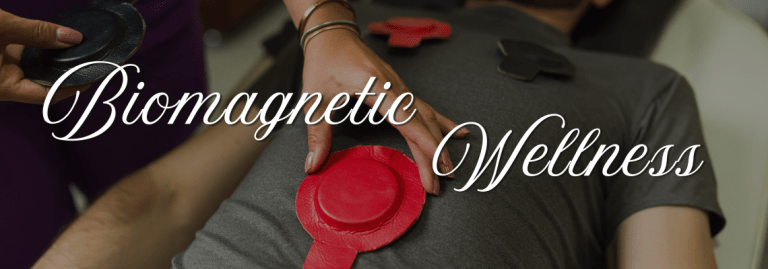Glossary of Biomagnetic terms
Glossary of Biomagnetic terms helps new wellness seekers understand biomagnetism on a basic level. We have provided some of the terms you will come across while practicing Biomagnetic Pair therapy. We hope this clears up any confusion you may have.
Acidity – Low concentration of hydrogen ions; pH less than 7.
Alkalinity – High concentration of hydrogen ions; pH greater than 7.
Bacteria – Prokaryotic unicellular microorganism (without nuclear membrane) capable of causing infection and disease.
Biomagnetics – The science of processes and functions in living organisms induced by the static magnetic fields
Depolarize – or impact: When the therapist places the magnets on the two points of a biomagnetic pair for the necessary time until the energy balance is restored and the pair is neutralized.
Electromagnetism – A branch of science studying the relation of electricity to magnetism. Also, magnetic action induced by an electric current.
Energetic resonance – In Biomagnetic Pair Therapy two poles are in energetic resonance when they have equal charges, frequencies and intensity; they are said to form a biomagnetic pair.
Fungi – Kingdom to which a broad set of organisms without chlorophyll belong so they get their nutrients from other organisms.
Gauss – The unit of magnetic flux density or how strong the magnetic field is at the surface level. Can be measured with a gauss meter.
Hemibody – Half of the body, either the right or the left.
Impact – or depolarize: Place the magnets in the two points of a biomagnetic pair for the necessary time until the energy balance is restored.
Keepers – Soft iron pieces connected with the different poles of magnets so that the magnets do not lose their magnetism. The soft iron pieces become induced magnets closing the molecular chain so that there are no free poles to get demagnetized over the course of time.
Kinesiology -Technique developed in the 60s by Dr. George Goodheart. The study muscle groups in relation to efforts, stress and their relationship with the organs and meridians of acupuncture.
Magnet – A body or piece of iron, steel or alloy, to which the properties of attraction and repulsion have been imparted and which possesses the quality of attracting iron particles to itself.
Ceramic Magnet – A magnet made of any synthetic material like the potter’s clay, iron-oxide, etc. or any other product that is first shaped and then hardened by means of heat.
Metallic Magnet (cast alloy) – A magnet made of any metal such as iron, steel, etc. or of a mixture of metals called cast alloy.
Magnetic Field – The space surrounding a magnet over which the magnetic force is felt. The space is permeated by magnetic lines of force. The magnetic field is most intense near the poles of the magnet.
Magnetic Flux – The discharge or flow of magnetic force or the magnetic field intensity
Magnetic Induction – Magnetization of a magnetic material when placed in proximity with a magnetic force, without actual contact with the magnet.
Magnetic Lines of Force – Continuous curve-lines in the magnetic field showing the direction of the magnetic force and the value of intensity for every point surrounding a magnet. Externally, the lines join North pole to South Pole and internally they pass from South pole to North Pole. The lines of force never intersect at any point.
Magnetic Material – Substances or materials such as iron, steel, nickel, cobalt, or any alloy, which are appreciably attracted by a magnet and can retain magnetism.
Magnetic Permeability – When a magnetic material is magnetized by induction, the lines of force of the magnetizing field get concentrated inside the material. The degree to which the lines of force can penetrate or permeate the material is known as permeability. In other words, the ratio of flux density to magnetizing force.
Magnetization – The act of rendering anything magnetic or imparting the property of attraction and repulsion to anything.
Magnetized Water – Water permeated with magnetic force by continuous contact with a magnet.
Magnetism – The science which deals with the properties of magnet, namely, attraction and repulsion. The power of a magnet to attract or repel other magnetic material.
Magnet therapy – The science and art of treatment of various diseases through the medium of magnets.
Muscular intelligent response – Shortening phenomenon of the right hemibody, either as a response of the body to stimulation of a point with a magnetic field or due to a question posed by the mental effort of the biomagnetist or therapist.
Normal energetic level – Condition of a pH close to 7 (neutral) in which pathogens hardly proliferate.
Parasite – Organisms that sustain their life based on the organism of another species, usually feeding on what the “host” produces. Sometimes harmoniously coexisting and sometimes causing illness.
Pathogen – Germ, an infectious agent capable of generating disease in an organism.
Polarization – The act of acquiring or giving polarity, or developing new meanings and qualities.
Pole – The extremity of any axis about which forces acting on it are symmetrically disposed. One of the two points in a magnet, cell or battery having opposite physical qualities.
pH – Degree of acidity or alkalinity of a substance. It is measured on a logarithmic negative scale of the concentration of hydrogen ions, scale from 0 to 14.
Polarity – Binary manifestation of several phenomena, including electromagnetism that manifests itself with a positive and a negative pole.
North Pole – The end of the earth’s axis in the Artic region. That pole of a magnet, which when free, points to earth’s north magnetic pole. Usually represented by the color red on a magnet, or as Positive.
Reservoir – Biomagnetic pair in which pathogens are lodged that are regularly located in other pairs.
Scanning – or Testing, is the action of placing a (negative) magnet on different points of the body to find bioenergetic alterations.
Scanning/Testing Protocol – It is a certain sequence of points that are tested to find the biomagnetic pairs. There are different protocols for general use and others established by biomagnetists personally.
South Pole – The end of the earth’s axis in Antarctica. The direction in which the South (south seeking) pole of a pivoted magnet will point. Usually represented by the color black on a magnet, or as Negative.
Virus – Microorganism composed of genetic material protected by an envelope capable of replicating inside a cell and causing disease.



